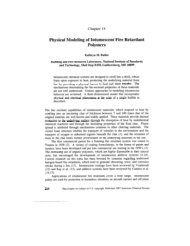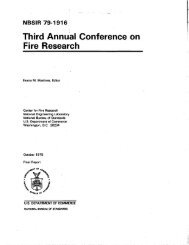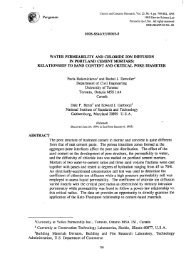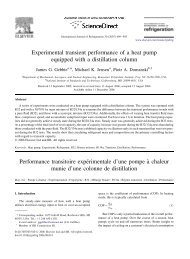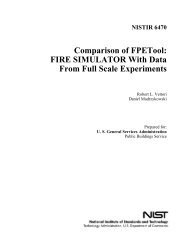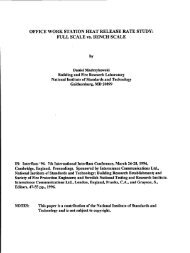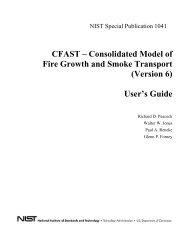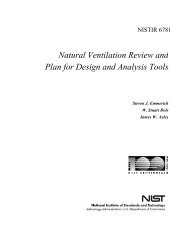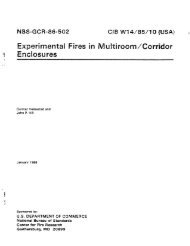Study of Technology for Detecting Pre-Ignition Conditions of ... - NIST
Study of Technology for Detecting Pre-Ignition Conditions of ... - NIST
Study of Technology for Detecting Pre-Ignition Conditions of ... - NIST
You also want an ePaper? Increase the reach of your titles
YUMPU automatically turns print PDFs into web optimized ePapers that Google loves.
,<br />
asc-fiG95-1145<br />
eletici~ into eight separate circuits. Electric ranges require between 208 V and 240 V, and<br />
they are rated <strong>for</strong> each. Since 240 V provides approximately one-third more heating power than<br />
208 V and it is the most mmmon range voltage in single family homes, it was desirable as a both<br />
a typical and more hazardous case. The required 240 V usually consists <strong>of</strong> two lines <strong>of</strong> 120 V ~,<br />
each and a neutral. The 220 V house circuit was boosted to 240 V by increasing one <strong>of</strong> the lines<br />
from approximately 115 V to about 130 V. A separate circuit breaker was installed particularly ~<br />
<strong>for</strong> the range. Current meters were used on the two lines to monitor the amperes drawn by the -“<br />
range, and a third meter monitored the power usage in kilowatts on the boosted line.<br />
Nat&al gas was provided through a 1.3 cm (0.5 in) tiside-dimeter pipe connected to the<br />
low-pressure house supply. The low-pressure gas came into the pipe at 3.0-3.5 kPa (12-14 inches<br />
<strong>of</strong> E@). A pressure regulator in the line was adjusted to decrease the pressure to 1.74 kPa<br />
(7.o inches <strong>of</strong> HzCl). The natural-gas pressure was monitored with a pressure gauge tapped into<br />
the line, and the flow was monitored with a 4.7 LJmin (10 SCFH) rotameter.<br />
2.1.2 Kitchen Ranges and Range Hood<br />
Three different ranges were to be tested: A - electric with open-coil sheathed heating<br />
elements; B - gas; and C - electric with a smooth top. The first two were tested extensively, but<br />
the electric smooth top was used <strong>for</strong> only two tests. Each range is 76 cm (30 in) wide and freestanding.<br />
The electric range with open-coil elements has two 15 cm (6 in) and two 20 cm @ in)<br />
burners. The 15 cm and 20 cm burner elements are rated at 1325 W and 2350 W, respectively,<br />
<strong>for</strong> 240 V electricity. The front bmers facilitated the setting up <strong>of</strong> measuring iw~ments, so<br />
the right front 20 cm burner was utilized <strong>for</strong> the tests since it was the largest <strong>of</strong> the two front<br />
burners. The high-output gas range has two typical-power, 2.6 kW (9000 BTU/h) sealed burners<br />
and two hl@-power, 3.5 kW (12000 BTU/h) sealed burners. The left front burner was utilized<br />
<strong>for</strong> the tests since it was the only high-output burner in the front. The smoothtop electric range,<br />
including the oven and burners, is rated <strong>for</strong> 11.4 kW at 120/240 V and 8.6 kW at 120/208 V.<br />
The range hood is a 76 cm (30 in) wide model made <strong>of</strong> stainless steel, and it has a 94 L/s<br />
(2OO cfm) flow capacity. The hood opening extends 45 cm (18 in) out from the wall and tapers<br />
from about 75 cm (29.5 in) wide at the wall to 60 cm (24 in) at the front over the frontmost<br />
15 cm (6 in). It was either <strong>of</strong>f or engaged at maximum flow <strong>for</strong> each experiment.<br />
2.1.3 Parmetiic Experiments<br />
Parametric experiments were conducted so the results could be used to establish a test plan<br />
detiiling the conditions <strong>of</strong> the ins~mented experiments. The purpose <strong>of</strong> these preliminary<br />
experiments was to detemine the effects <strong>of</strong> pan material, shape, and size, and the amount <strong>of</strong> food<br />
on the temperature <strong>of</strong>, time to, and mode <strong>of</strong> ignition <strong>of</strong> the food. These expetimenti (the first<br />
five; Table 1) were conducted on a typical, inexpensive gas range with four medium output, 2.6<br />
kW (9000 EWWhr) unsealed burners. The primary food tested was corn oil. One tiemomuple<br />
in the oil monitored the temperature, and a stopwatch was used to time the observations.<br />
Several tests were conducted with a simple procedure. The pan was secured with a ring<br />
stand clmp tightened on the pan handle to prevent spillage. Using a graduated cylinder, an<br />
4



